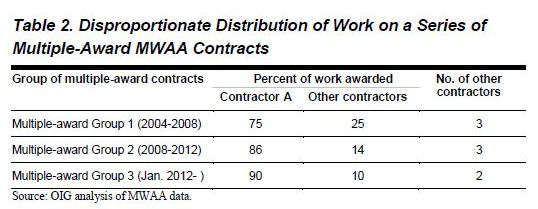 An audit of MWAA management practices found that a mysterious “Contractor A” charged more than other contractors for the same work — and kept getting business. Who is this company? Who got the money? And why doesn’t anyone seem to care?
An audit of MWAA management practices found that a mysterious “Contractor A” charged more than other contractors for the same work — and kept getting business. Who is this company? Who got the money? And why doesn’t anyone seem to care?
by Bob Bruhns
At the request of Representatives Frank Wolf, R-VA, and Tom Latham, R-IA, the Office of the Inspector General of the U.S. Department of Transportation audited the management of the Metropolitan Washington Airports Authority last year. On November 1, 2012, the Inspector General issued the final report on its audit. The title said it all: “MWAA’s Weak Policies and Procedures Have Led to Questionable Procurement Practices, Mismanagement, and a Lack of Overall Accountability.”
Not only were high-priced contracts awarded improperly, the auditors found, but one particular contractor was winning an inordinate number of contracts despite the fact that it charged much more than other contractors.
MWAA mismanagement was endemic. States the report:
MWAA issued out-of-scope contract actions over $200,000 — including contract modifications and task orders — without required Board approval. From our statistical sample of 24 out of 343 active MWAA contracts, we identified 8 for which MWAA issued a total of 20 out-of-scope contract actions with a combined value of $57 million. Based on these findings, we project that MWAA has issued $107.6 million in out-of-scope contract actions on contracts active as of June 2011.
The report goes on to discuss an unidentified “Contractor A” that won a disproportionate number of contracts even though it charged more for its services:
Over the past 8 years, MWAA awarded more than 80 percent of work under three groups of multiple- award contracts to a single contractor (“Contractor A” in table 2). However, the contractor’s rates were often higher than the other multiple-award contractors’ rates. For example, the contractor’s rates in a 2012 contract were between 28 percent and 234 percent higher. While MWAA may have had non-price related reasons for selecting Contractor A, this unbalanced distribution of work to a single contractor with significantly higher rates appears contrary to the purpose of multiple-award contracts..
So, the inspector general’s report estimates that there was about $108 million in improper contracting — just in the contracts that happened to be active in 2011 – and that Contractor A benefited from eight years of contracts billed at a rate that the report typifies as 1.28 to 3.34 times what other contractors charged for the same work.
The report continues: “In addition, MWAA allowed Contractor A to add job categories to a contract but did not offer the other multiple-award contractors the same opportunity. Thus, when MWAA ordered work related to those additional job categories, they were effectively sole-source awards because only one contractor was able to accept the work.”

It is hard to avoid the appearance that MWAA was funneling multimillion-dollar contracts to Contractor A at higher-than-market rates.
The report continues: “In July 2012, MWAA’s Procurement and Contracts Department established guidelines requiring contracting officers to select contractors under multiple-award contracts for temporary staff. However, this policy only applies to temporary staffing contracts rather than to all multiple-award contracts.”
In other words, as of July 2012, MWAA policy apparently still allowed the selective multiple award contracting that it undertook for years with Contractor A. Read more.


